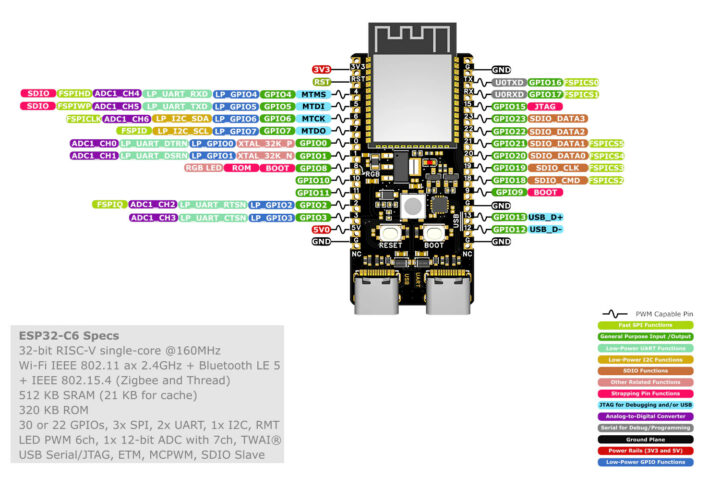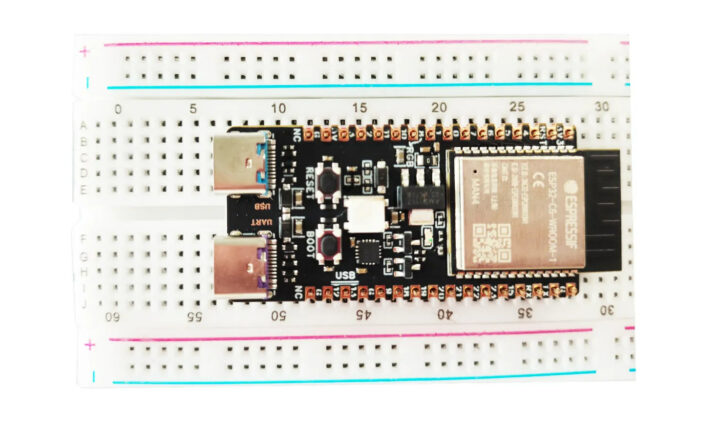As expected, Espressif has just released the ESP-IDF 5.1 framework with ESP32-C6 and ESP32-H2 support, so more ESP32-C6 boards should become available, and after Olimex ESP32-C6-EVB launched earlier this week, we’ve noticed WeAct had introduced a low-cost ESP32-C6 development board that sells for just $6.43 plus shipping a few weeks ago.
WeAct ESP32-C6 board
The WeAct board offers 2.4 GHz WiFi 6, Bluetooth LE 5.0., and Zigbee/Thread connectivity through the ESP32-C6-WROOM-1 module, two USB-C ports, two 16-pin headers for GPIOs, and if it looks familiar, it’s because it closely follows the design of the official ESP32-C6-DevKitC-1 development kit, albeit with some small modifications.
WeAct ESP32-C6 board specifications:
- Wireless module – ESP32-C6-WROOM-1 with
- ESP32-C6 single-core 32-bit RISC-V clocked up to 160 MHz, with 320KB ROM, 512KB SRAM, low-power RISC-V core @ up to 20 MHz
- Wireless – 2.4 GHz WiFi 6, Bluetooth 5.0 LE, 802.15.4 radio for Zigbee 3.0 and Thread. Matter compatible. PCB antenna
- Storage – 4MB or 8MB SPI flash
- USB – 1x USB Type-C host port, 1x USB Type-C port via UART console
- I/Os – 2x 16-pin headers with GPIO, UART, SPI, ADC, SDIO, USB, I2S, etc…
- Misc – RESET and BOOT buttons, RGB LED
- Power Supply (mutually exclusive options)
- 5V via USB-UART port (recommended)
- 5V and GND pins
- 3V3 and GND pins
- Dimensions – 51.8 x 25.5 mm

Since the board is most a copy of the official Espressif board, WeAct does not provide its own documentation but instead links to Espressif’s documentation website directly where you’ll find instructions to get started with the ESP-IDF framework using either Eclipse or VSCode IDEs.
The WeAct “ESP32-C6-A-N4” board that sells for about $6 comes with a 4MB SPI flash, but if you’d rather get an 8MB SPI flash, the ESP32-C6-A-N8 goes for $8.17.
ESP-IDF 5.1 framework release
As mentioned in the introduction the ESP-IDF 5.1 framework has just been released. The main change is support for ESP32-C6 and ESP32-H2 microcontrollers with both integrating an 802.15.4 radio for Zigbee 3.0, Thread/OpenThread, and Matter.
There’s also a long list of other features:
- Bluetooth
- Bluetooth support use main XTAL in light sleep mode on ESP32-C3/ESP32-S3
- Bluetooth to release .bss and .data segment memory on ESP32-C2, ESP32-C3, and ESP32-S3
- NimBLE – Added stack support for LE Power Control, migrated to nimble-1.5
- Wi-Fi
- Added WPS registrar support in SoftAP mode
- Added support for SAE-PK (Public Key) authentication for station
- Added support of WPA3 Personal (SAE) in SoftAP
- Added Wi-Fi Aware (NAN) support (only ESP32/ESP32-S2 for now)
- Added support for WPA2/WPA3, mixed mode for SoftAP
- OpenThread
- Added support of Ethernet interface for Openthread br
- Supported CSL feature
- Supported Link Metrics feature (bb9200a)
- Added SPI support in Radio Co-Processor
- Coexistence
- Added external coexistence (leader mode) support on ESP32-S3 and ESP32-C2
- Added external coexistence (follower mode) support on ESP32-C2
- Added force RX mode in external coexistence on ESP32-C2
- ULP – Added support for RTC I2C to ULP RISC-V on ESP32-S2 and ESP32-S3
- WDT – Support Interrupt WDT and Task WDT on ESP32-C2
- USB
- Added support for UVC Host Class (see the UVC Host Class Driver component for more details) and accompanying example
Added Mass Storage Device example
- Added support for UVC Host Class (see the UVC Host Class Driver component for more details) and accompanying example
- And more…
The ESP-IDF 5.1 also implemented some major bug fixes (timing issues, RTC bugs, etc..), and introduced some breaking changes which mean code written for the ESP-IDF 5.0 may not work with the ESP32-IDF 5.1. Having said that, the company says the “release v5.1 is mostly compatible with apps written for ESP-IDF v5.0”, so most people may not encounter those breaking changes.
The recommended way to get the new version of the framework is through git:
|
1 2 |
git clone -b v5.1--recursive https://github.com/espressif/esp-idf.git esp-idf-v5.1 cd esp-idf-v5.1/ |
You’ll find all changes in the release announcement on GitHub, as well as updated documentation for the ESP-IDF 5.1 on Espressif’s website.

Jean-Luc started CNX Software in 2010 as a part-time endeavor, before quitting his job as a software engineering manager, and starting to write daily news, and reviews full time later in 2011.
Support CNX Software! Donate via cryptocurrencies, become a Patron on Patreon, or purchase goods on Amazon or Aliexpress






Super Cool!!
Since the radio does 802.15.4, can it do the nRF 2.4 GHz protocol? That would be a very useful additon for them to make.
Nrf24 (FSK) is closer related to BLE than to 802.15.4, actually Nordic heavily pushed their way of working during standardisation of BLE it seems.
The problem is usually that noone is willing to give out any data on how to use the radio registers, else I guess many BLE chipsets could be used to interoperate with nrf24 on 1M and 2M data rates. As far as I can tell the lora sx1280 can probably do this…
Thanks for the backgrounder!
I see the problem with the BLE side of things being the part that might Nrf24 as it and WiFi are more hevily locked down. 802.15.4 radios tend to be a bit more open–which is why I was curious if this was an option.
Yupp thats exactly the crap with BLE…
There is one or 2 texas instruments cc2653 or something like this that seem slightly better documented, but still no fun. There are a couple of zigbee usb sticks with this chip on the market. Newer got to play with any of those.
I shouldn’t have reread my post. Holy cow, how did I spell everything wrong?
I meant to say that the BLE hardware was more similar to NRF24 in modulation, etc. than it was similar to the WiFi hardware. And that BLE is less locked down than WiFi tends to be.
Stupid regulatory bodies killing off SDR.
One of the big issues on the original ESP32 when it came to BLE is that you basically had to wake up the whole ESP32 before you could send or receive anything over BLE, which is slow and power-hungry. That ruled out completely the ability to perform BLE advertisements on a battery-operated device which could last for months. I wonder if they made any changes to that and if the hardware now supports waking up quickly in a low power state just sufficient to send and listen for the minimum amount of time (and only go to higher levels if… Read more »
No idea, but the mention of the presence of a low-power 20 MHz core might be related precisely to this. At least it would make sense!
Esp32-c6 is for gateway devices, esp32-h2 is for end devices.
I can now see the WeAct ESP32-C6-A-N4 board sold for $2.26 as part of a welcome deal (even though I’m logged in).
https://s.click.aliexpress.com/e/_DDiwFiH